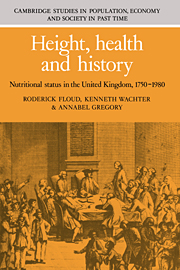Book contents
- Frontmatter
- Contents
- List of figures
- List of tables
- Preface
- 1 Height, nutritional status and the historical record
- 2 Inference from military height data
- 3 Inference from samples of military records
- 4 Long-term trends in nutritional status
- 5 Regional and occupational differentials in British heights
- 6 Height, nutritional status and the environment
- 7 Nutritional status and physical growth in Britain, 1750–1980
- 8 Conclusions
- Bibliography
- Index
3 - Inference from samples of military records
Published online by Cambridge University Press: 05 November 2011
- Frontmatter
- Contents
- List of figures
- List of tables
- Preface
- 1 Height, nutritional status and the historical record
- 2 Inference from military height data
- 3 Inference from samples of military records
- 4 Long-term trends in nutritional status
- 5 Regional and occupational differentials in British heights
- 6 Height, nutritional status and the environment
- 7 Nutritional status and physical growth in Britain, 1750–1980
- 8 Conclusions
- Bibliography
- Index
Summary
INTRODUCTION
In the last chapter, we argued that military recruitment can be analysed within the framework of the operations of the labour market in eighteenth- and nineteenth-century Britain. But it remains possible that, because of variations in labour market conditions over time or because of the vagaries of sampling from the large bodies of military records, samples of military recruits could still not provide a good guide to the nutritional status of the British working class. The two issues, though logically distinct, are intimately related because of the unavoidable fact that our only direct knowledge of the recruits, of their occupations, places of birth and place within the labour market, comes from those very samples. In this chapter, therefore, we examine those samples and compare them with various other evidence about the working class.
INFERENCE FROM THE SAMPLES TO MILITARY UNITS
Most of the newly collected data used in this book are the result of a selection of evidence about individuals from military records. The bulk comes from the Description Books of the British Army and the Royal Marines, held in the Public Record Office. They are supplemented, however, by the records of the Royal Military Academy, held at Sandhurst, and by the records of the Marine Society, held at the National Maritime Museum.
- Type
- Chapter
- Information
- Height, Health and HistoryNutritional Status in the United Kingdom, 1750–1980, pp. 84 - 133Publisher: Cambridge University PressPrint publication year: 1990

